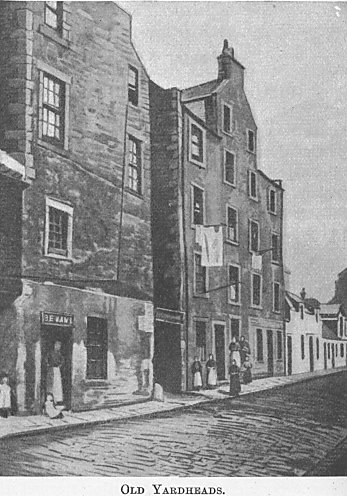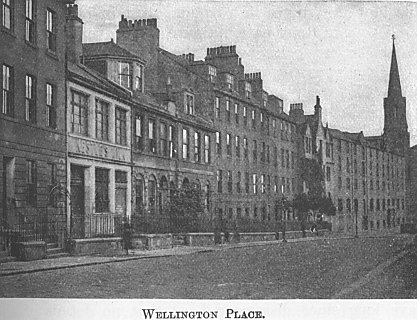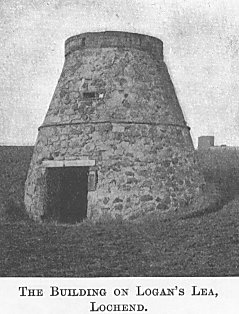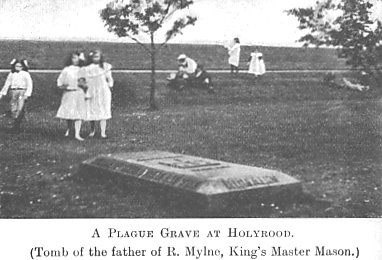|
JUST as a wave of pestilence seemed to follow
in the wake of the Great War with Germany, so in those evil days of civil
war in England between Cavaliers and Roundheads, and of the fierce and
savage campaign of Montrose in Scotland, Leith and Edinburgh were
desolated with the last and most terrible outbreak of the plague they were
ever to know. Sir Thomas Hope, the great Puritan lawyer of Charles I.’s
time, as he sat in his stately old mansion, now displaced by the Edinburgh
Public Library, records in his diary under May 12, 1645, "A dauchter
of Sir William Gray’s departit of the plaig, which put us all in greit
fear." The dread scourge broke out in Leith about the same time, for,
dated 3rd April, is the following ominous entry in the South Leith Church
Records: "To furnish provisions fur ye woman at ye Yarde heads who is
steekit up (that is, shut up in her house) for feare of ye plague."
These cases were but the
heralds of a fast approaching scourge. Soon death and desolation reigned
in every street, and to add to the horror of the situation the pestilence
was accompanied by famine, for the harvest of the previous year had been a
failure. In old-time Scotland plague, or the pest as it was usual to call
it then, frequently followed times of scarcity, and this, together
with the distress and anxiety caused by the protracted civil strife, had
so reduced the vital power of the people that their bodies, thus weakened,
were unable to resist the attacks of the pestilence. The filthy and
evil-smelling streets, which were never cleansed, were in themselves
fruitful sources of disease.
 All
who could, as in the severe outbreaks of 1475 and 1504, fled the town. As
a result the infected were frequently left unattended, and in this way the
death roll was largely increased. Dread of the plague made the people
utterly selfish, a heartlessness of which we are still reminded by the
saying, "to shun a person as if he had the plague." Where those
who thus heartlessly forsook their friends and neighbours betook
themselves we are not told, but wherever they had gone it was resolved to
tax them for the support and maintenance of the poor of the town. All
who could, as in the severe outbreaks of 1475 and 1504, fled the town. As
a result the infected were frequently left unattended, and in this way the
death roll was largely increased. Dread of the plague made the people
utterly selfish, a heartlessness of which we are still reminded by the
saying, "to shun a person as if he had the plague." Where those
who thus heartlessly forsook their friends and neighbours betook
themselves we are not told, but wherever they had gone it was resolved to
tax them for the support and maintenance of the poor of the town.
Among those who remained
and did their best for the suffering people were the minister, the Rev.
Mr. Sharp, and the session clerk, David Aldinstone—Mr David he was
respectfully called by the parishioners. One of his duties was the writing
of the minutes of the session meetings. Mr. David’s minutes at this time
and for many months to come are wholly taken up with the plague which was
absorbing all men’s thoughts.
The minute-book, of seven
hundred and sixty-five closely written pages, is entitled "Register
of S. Leith Church, 1643 to 1660," and forms a valuable record of one
of the most eventful periods in the history of the town, the period of the
strenuous fight of the Army of the Covenant, of the last and greatest
visitation of the plague, and of the invasion and occupation of the town
by Cromwell’s Tronsides, who for seven years closed the two parish
churches to their congregations, and used them as storehouses for their
artillery and other munitions of war. Save in Defoe’s Journal of the
Plague Year in London, a highly imaginative work of fiction be it
remembered, based on hearsay, no more interesting account of the ravages
of plague and the efforts to cope with it Was ever penned than that of Mr.
David Aldinstone in the old session minute-book.
The Kirk Session, who in those times
exercised a large police jurisdiction over the town, along with the Water-bailie
and his Deputy, set themselves, as was usual in times of plague, to
prevent the spread of the disease rather than to relieve those whom it had
already stricken.
In doing this they took very enlightened
measures. They instinctively felt that the cleansing of the town was the
best way to check the scourge "quhilk be the Grace of God and good
governance may be stanchit." But the cleansing of the streets was no
easy task. Some idea of their state may be gathered from the first
intimation on the subject, which declared that every one remove the
middens and dead swine off the streets. (Pork was then very generally
eaten. The pigs were housed beneath the outside stairs, and many had died
from want of food, as their owners were either plague-stricken or dead.)
There was no town cleansing department in
those days. Week after week, and month after month, carts were employed in
this work, which became more and more difficult to accomplish as the
plague spread and carried off one after another of the workers. The
various cart-loads were, at first, laid down on the Sands within
high-water mark, so that the flood-tide would carry them out to sea. To
expedite the work, all those who rented fields or farms round the town
were, on pain of being "laid fast in prison," to carry out the
street refuse and lay it on their land. Then, in spite of the wages of
those thus employed being raised, no new men for the work could be had,
and so women and boys, especially those who had recovered from the plague,
as they were not so liable to be again affected, were commandeered for
this work, under threat of imprisonment! if they refused.
The members of the Kirk Session reported
all cases of sickness to the two
Bailies, but after a few days it was found that Bailies and Session were
quite inadequate to cope with the work, and a meeting was held in the
Tolbooth to make up a roll of helpers.
Men called quarter-masters were appointed
to visit the different quarters of the town and report all new cases of
plague. When the plague broke out in a family they had to indicate the
fact by hanging a white cloth from their house. It was then the duty of
the quartermasters, as a preventive against infection, to lock them in and
go round daily with their supply of food—three half-loaves and two
quarts of ale each day. Tea and coffee were not yet in use. On the death
of the infected member of the family, the others with their gear—that
is, their household goods—of which people possessed much less then than
now, were removed to a plague camp on the Links, where they were housed in
"ludges" or wooden huts for many days till all fear of infection
was gone. Meanwhile their houses were closed up until they were "singit
and fyrit with hether "—that is, until they were thoroughly
disinfected with the smoke of burning straw, whins with which the Links
were then covered, or heather from the heathery braes around Pilrig and
the Gallow Lee. After this process they were cleansed by being scrubbed
out. But there was serious risk of fire from this singeing by the "smeikers."
Just two months before the town of Kelso had thus been completely burned
down by the cleansing of "ane of the houses thereof whilk was
infected by the plague." For this reason, before any house was
disinfected, "puncheons" of water were placed beside it in case
of fire to sloken the same." The day of water mains and fire engines
was as yet far off.
The number of "ludges" went on
increasing as the infection spread, and soon a regular town of them was
built on the Links, divided into quarters to correspond to the quarters of
the town. There were three great groups of these huts—one beside the
Boothacre at Seafield, to which they probably gave the name; another stood
between Links Place and Charlotte Street; while the position of the third
is nowhere stated. An overseer was appointed for the "ludges"
who was provided with a horse. It was his duty to ride round morning and
evening to provide the occupants with their needful food from a store or
magazine house in the neighbourhood of the huts. Quarter-masters were
appointed for the Links as well as the town, but their courage must have
failed them, as the overseer, Alexander Hay, complained that none would
tend those there placed in quarantine save himself. But his own spell of
office was short. Within a month he had fallen a victim to the plague, and
after much difficulty a new overseer was at last found courageous enough
to undertake the duty.
But now the supply of food
began to fail. The famine had set in and supplies had to be obtained from
Musselburgh and elsewhere, but they had to be paid for. It is impossible
for us in our day to realize the gloom, the terror, and the distress of
the folk of Leith at this time. The streets were deserted, for even those
who had as yet escaped the attack of the scourge dreaded meeting their
neighbours for fear of infection. The horse in the dead cart had to be
taken to Restalrig, where the plague also raged, to be shod, as no smith
could be found at work in Leith. Perhaps it is to the sorrow and sadness
of this time we owe the legend in large Roman lettering over the old
doorway in St. John’s Close, Canongate: THE LORD IS ONLY MY SUPORT, for
to arrest the progress of the plague seemed beyond the power of man.
 For
the first few weeks after the outbreak the victims of the pestilence were
buried in the churchyard. But the dead now became so numerous that to dig
individual graves was no longer possible. Besides, it was feared the
infection might burst forth anew if ever the graves were reopened for
future burials. The dead were now buried on the Links in great trenches,
mostly in the neighbourhood of Wellington Place, where their remains are
frequently uncovered in digging the foundations of new buildings. Those
who died in the plague camp at Boothacre were interred on the Links near
Sea-field, at first in "deid kysts," or coffins, and then simply
in the blankets in which they died, "for the number of the dead
exceeds the number of the living, and some lyeth long unburied." To
avoid infection as far as possible the removal and burial of the dead was
done under silence of night. In Leith the dead-cart was William Strachan’s
slaid—that is, sledge—a common form of cart everywhere in earlier
days, and on its side was hung "ane bell whilk sal make warning to
the people." For
the first few weeks after the outbreak the victims of the pestilence were
buried in the churchyard. But the dead now became so numerous that to dig
individual graves was no longer possible. Besides, it was feared the
infection might burst forth anew if ever the graves were reopened for
future burials. The dead were now buried on the Links in great trenches,
mostly in the neighbourhood of Wellington Place, where their remains are
frequently uncovered in digging the foundations of new buildings. Those
who died in the plague camp at Boothacre were interred on the Links near
Sea-field, at first in "deid kysts," or coffins, and then simply
in the blankets in which they died, "for the number of the dead
exceeds the number of the living, and some lyeth long unburied." To
avoid infection as far as possible the removal and burial of the dead was
done under silence of night. In Leith the dead-cart was William Strachan’s
slaid—that is, sledge—a common form of cart everywhere in earlier
days, and on its side was hung "ane bell whilk sal make warning to
the people."
In the older portion of
South Leith Churchyard, the part on the south side of the church, it is
very noticeable how the graves lie east and west in parallel rows, a relic
of pre-Reformation times. In Covenanting days we are led to believe that
the people sternly turned their backs on everything that savoured of the
old faith. Yet the plague graves, both at Wellington Place and the
Boothacre, hasty as the interments must have been, all lie east and west,
while the bodies, apparently without exception, had been buried with the
hands crossed or in the attitude of supplication like the prereformation
effigies of the Forresters in Corstorphine Church. Where there were
coffins they were of plain fir deals—that is, they were of home-grown
timber and bore no signs of ever having been covered or decorated with
cloth, which was not customary at that time.
The records of North Leith
Church for this period have long since disappeared, so that no details of
the ravages of this last visitation of the plague in North Leith are now
known. Remains of interments have been found near the coast between Leith
and Newhaven. These were supposed at the time to have been the graves of
Cromwell’s soldiers who died during theft occupation of Leith from
September 1651 to the close of the year 1659. They are more likely to have
been those of victims of the plague.
 In
the vicinity of the plague camps the clothes and other effects of the
stricken or suspected persons were purified by being boiled in large
cauldrons erected over peat fires in the open air. They were then further
disinfected by being smoked in kilns built for this purpose. One of these
cauldrons came from the brewery of James Storrie,
who is no doubt name-father to Storrie’s Alley. A kiln, convenient both
for Leith and Restalrig, was erected on Logan’s Lea, the meadow-land
beside the loch at Lochend, where, curiously enough, an old building like
a kiln stands to-day beside the allotments on the rising ground just north
of the loch. Local tradition, which so frequentlv leads us astray
in the story of Leith, declares this building to have been a dovecot, but
an examination of the interior would seem to disprove this belief. In
the vicinity of the plague camps the clothes and other effects of the
stricken or suspected persons were purified by being boiled in large
cauldrons erected over peat fires in the open air. They were then further
disinfected by being smoked in kilns built for this purpose. One of these
cauldrons came from the brewery of James Storrie,
who is no doubt name-father to Storrie’s Alley. A kiln, convenient both
for Leith and Restalrig, was erected on Logan’s Lea, the meadow-land
beside the loch at Lochend, where, curiously enough, an old building like
a kiln stands to-day beside the allotments on the rising ground just north
of the loch. Local tradition, which so frequentlv leads us astray
in the story of Leith, declares this building to have been a dovecot, but
an examination of the interior would seem to disprove this belief.
The plague began in April,
and raged all the summer and autumn, but the cold and storms of winter
came as a blessing to the stricken town. The scourge then began to abate,
and, after threatening more than once to break out again, disappeared with
the approach of spring. The population of South Leith before the outbreak
could hardy have exceeded 4,000 people. Of this number 2,421. or
considerably more than half, had been carried off.
In Restalrig the victims
numbered 160, while in the Craigend or Calton there died 155. The total
for the whole parish was therefore 2,736. Many houses were left
uninhabited, as their occupants had fallen victims to the ravages of the
plague. The town was left overwhelmed with debt, her trade had been
brought to a standstill, and it was years before she regained her wonted
prosperity. Unless the kiln at Lochend be one, there is no other memorial
of this piteous time in Leith save the graves of the unknown victims.
Edinburgh possesses three interesting memorials of this last and most
terrible visitation of the plague—in the tombstone in the grounds of
Bruntsfield House, the Morocco Land in the Canongate, and the "plague
ceilings" in Brodie’s Close, Lawnmarket, with the dates 1645 and
1646, showing that the work was suspended during the pestilence and
completed when it had passed in 1646.

|

